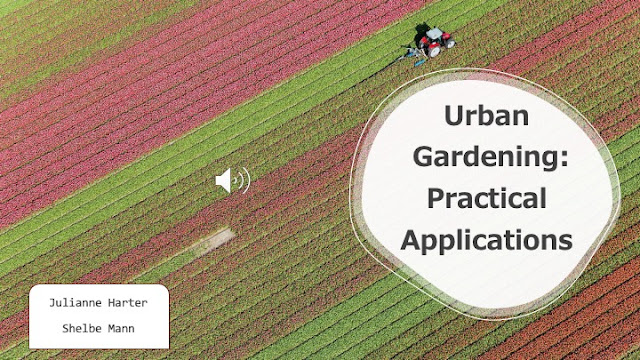Project Name: Urban Gardening: Practical Applications
Names: Julianne Harter & Shelbe Mann
Roles: Julianne- Original concept, garden knowledge, research
Roles: Shelbe- Research, Power Point
Goals: Learners will gain the skills and knowledge of how to utilize local resources and successfully produce an urban garden in the outdoor classroom setting.
Objectives: Upon completion of the training learners will be able to:
- Learn the best approach to building a “lasagna” layered raised bed garden.
- Gain the knowledge toward properly establishing seedlings and other types of plants for the raised garden.
- Observe and interact during the growing season.
Rationales:
Merriam and Baumgartner (2020) shared, “John Dewey’s view of experience and learning and the connection between life experiences and learning…learners must connect what they have learned from current experiences to those in the past as well as see possible future implications.” Dewey’s views closely align with Kolb’s conceptualized four-stage model of experiential learning…(p198).
Merriam and Baumgartner (2020) provided, “Kolb conceptualized that learning from experience requires four different kinds of abilities: (a) openness and willingness to involve oneself in new experiences (concrete experience); (b) observational and reflective skills so these new experiences can be viewed from a variety of perspectives (reflective observation); (c) analytical abilities so integrative ideas and concepts can be created from their observations (abstract conceptualization); and (d) decision-making and problem-solving skills so these new ideas and concepts can be used in actual practice (active experimentation,[AE])…as a cyclical process…”
- Connection between past and present (John Dewey)- Learners introduce themselves, reason for in the class, their informal knowledge, and what they are hoping to learn.
- Concrete Experience-Learners cultivate a new skill or build on current skill.
- Reflective Observation-Learners reflect and recount their experience to develop understanding.
- Abstract Conceptualization-Learners use logic and concepts instead of inklings to understand the dilemmas or solutions.
- Active Experimentation- Learners take the cultivated practical skills and put them into action to see if they succeed or fail.
Design: Learners are fully immersed in interactive and hands-on approach to building a raised garden bed, with observation, practice, and use of tools provided. So that they may replicate in another setting.
Introduction: Connection between past and present.
Learners introduce themselves, a brief statement on why they are attending the course, what they are hoping to learn, and any previous experience/informal knowledge.
Module #1: Introduction to Gardening
Content/Activity:
- Overview of the learning goals and expectations.
- Introduction to what is needed to build a raised garden bed.
- Power Point presentation.
- Video on how to build a raised garden bed.
- Handouts with information on seedlings, “lasagna” soil layering, and complementary plants.
- Open discussion and questions
Concrete Experience:
Having learners build a raised garden bed and implement “lasagna” layering of soil will provide a new skill and/or build on current skills for a learner. Learners will have an introduction via the teachers, Power Point, and videos to accomplish this goal.
Module #2: Feedback
Content/Activity:
- During this time learners will be given the time to discuss their prior proficiency in gardening.
- Learners will then connect their previous knowledge with the new information presented by the teachers and learning materials.
Reflective Experience:
Learners are talking about the new knowledge, fellow learners' experiences/knowledge, and hands-on experience they just encountered.
Module #3: Time to Build!
Content/Activity:
- Learners will then be broken up into groups of four and given plans on how to build a raised garden bed.
- They will build the raised garden bed.
- They will implement the “lasagna” layering of soil.
Abstract Conceptualization:
Learners will implement the new skill/knowledge they have procured through observation and discussion.
Module 4: Do It Yourself!
Content/Activity:
- Learners will plan and procure the materials needed.
- Learners will build a raised bed garden.
- Learners will implement the “lasagna” layering of soil.
- Learners will plant seedlings and tend to their needs.
Active Experience:
Learners implement what they have accomplished in the previous modules to replicate these plans for their own personal use.
Resources:
2020, 14 February, Jabari, S., Collig12, Leanne, & Herwald, D. (n.d.). Pricking out, potting on and transplanting: Step by step. GrowVeg. https://www.growveg.com/guides/pricking-out-potting-on-and-transplanting-step-by-step/
Merriam, S. B., & Baumgartner, L. M. (2020). Experience and Learning. In Learning in Adulthood A Comprehensive Guide (Fourth, pp. 196–227). essay, Jossey-Bass.
Vanderlinden, C. (2022, October 18). How to make a Lasagna Garden. The Spruce. https://www.thespruce.com/how-to-make-a-lasagna-garden-2539877
YouTube. (2019, October 2). How to build a raised bed cheap and easy, Backyard Gardening. YouTube. https://www.youtube.com/watch?v=MBIYebUgVVI
PPT










No comments:
Post a Comment